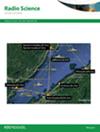基于非相干散射雷达的ANCHOR电离层数据同化模型验证
IF 1.5
4区 地球科学
Q3 ASTRONOMY & ASTROPHYSICS
引用次数: 0
摘要
ANCHOR是美国海军研究实验室开发的一种新型数据同化模型,用于与空间天气应用相关的临近预报电离层参数。ANCHOR利用卡尔曼滤波技术,将来自电离层探空仪的电子密度观测数据、阿贝尔反向无线电掩星(RO)数据和地面GNSS接收器数据整合到pyiri驱动的模型背景中。本研究的目的是用非相干散射雷达(ISR)在不同太阳活动水平下的电子密度观测参数来验证估计的模型参数。从2018年至2024年的6年数据集中,从位于本初子午线以西不同纬度的四个运行isr中收集了四个不同的事件:Arecibo, Jicamarca, Millstone Hill和Poker Flat。这些事件跨越了一系列太阳活动水平,其中两个事件处于太阳活动低水平,一个处于中等水平,一个处于太阳活动高水平,每个事件至少有两个雷达的数据覆盖。通过将Epstein函数拟合到电子密度分布图中实现参数提取,其中峰值密度(NmF2)、峰值高度(hmF2)以及底部和顶部厚度参数同时优化以表征F2层。利用isr提取的参数与模型输出进行直接比较,采用均方根误差(RMSE)分析方法。与背景模型相比,NmF2、hmF2和厚度参数的改进幅度高达75%,并且在所有纬度上都具有一致性。此外,将ANCHOR同化模型与PyIRTAM模型进行了比较,结果表明两种系统的性能具有良好的一致性。本文章由计算机程序翻译,如有差异,请以英文原文为准。
Validation of ANCHOR ionospheric data assimilation model using incoherent scatter radars
ANCHOR is a novel data assimilation model developed at the U.S. Naval Research Laboratory for nowcasting ionospheric parameters relevant to space weather applications. ANCHOR incorporates electron density observations from ionosondes, Abel inverted radio occultation (RO) data, and ground-based GNSS receiver data into a PyIRI-driven model background using the Kalman filter technique. The purpose of this study is to validate the estimated model parameters with parameters derived from electron density observations from incoherent scatter radars (ISR) at various levels of solar activity. Four distinct events were identified from a 6-year data set spanning from 2018 to 2024 collected from four operating ISRs located at varying latitudes west of the prime meridian: Arecibo, Jicamarca, Millstone Hill, and Poker Flat. These events span a range of solar activity levels, with two events at low solar activity, one at moderate and one at high solar activity, each with data coverage from at least two radars. Parameter extraction is achieved by fitting Epstein functions to the electron density profiles, where the peak density (NmF2), peak altitude (hmF2), and the bottomside and topside thickness parameters are simultaneously optimized to characterize the F2 layer. The ISR-extracted parameters are used to directly compare with the model outputs using the root mean square error (RMSE) analysis method. Up to 75% improvement relative to the background model for NmF2, hmF2, and thickness parameters with consistency across all latitudes is found. Additionally, the ANCHOR assimilative model was compared to PyIRTAM model, showing a good agreement between the performances of both systems.
求助全文
通过发布文献求助,成功后即可免费获取论文全文。
去求助
来源期刊

Radio Science
工程技术-地球化学与地球物理
CiteScore
3.30
自引率
12.50%
发文量
112
审稿时长
1 months
期刊介绍:
Radio Science (RDS) publishes original scientific contributions on radio-frequency electromagnetic-propagation and its applications. Contributions covering measurement, modelling, prediction and forecasting techniques pertinent to fields and waves - including antennas, signals and systems, the terrestrial and space environment and radio propagation problems in radio astronomy - are welcome. Contributions may address propagation through, interaction with, and remote sensing of structures, geophysical media, plasmas, and materials, as well as the application of radio frequency electromagnetic techniques to remote sensing of the Earth and other bodies in the solar system.
 求助内容:
求助内容: 应助结果提醒方式:
应助结果提醒方式:


